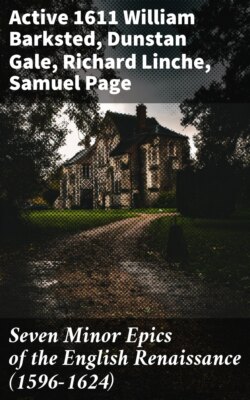Читать книгу Seven Minor Epics of the English Renaissance (1596-1624) - Linche Richard - Страница 6
На сайте Литреса книга снята с продажи.
FORMAL CHARACTERISTICS
ОглавлениеLike the poems reprinted by Professor Donno, these establish their identity as minor epics by the erotic subject matter of their narration, however symbolized or moralized, and by their use of certain rhetorical devices that came to be associated with the genre. These include the set description of people and places; the suasoria, or invitation to love; and the formal digression, sometimes in the form of an inset tale, such as the tale of Poplar in Mirrha (pp. 148–155). Other rhetorical devices cultivated in the epyllion are the long apostrophe, and the sentence or wise saying. Also, these poems employ numerous compound epithets and far-fetched conceits. (Dom Diego goes hunting with a "beast-dismembring blade" [p. 64], and Cinyras incestuous bed in The Scourge "doth shake and quaver as they lie,/As if it groan'd to beare the weight of sinne." [p. 261].)
The average length of these, like other Renaissance minor epics, is about 900 lines. Although the length of Renaissance minor epics is not rigidly prescribed, it is noteworthy that several of these poems have almost the same number of lines. Philos and Licia, Mirrha, and Hiren, for example, running to about 900 lines, vary in length by no more than 16 lines. (Amos and Laura, however, the shortest with about 300 lines, is some 650 lines shorter than The Scourge, the longest, with about 950.)
As well as echoing Marlowe's Hero and Leander and Shakespeare's Venus and Adonis in particular words and phrases, these poems reveal a much more general indebtedness to what Professor Bush has aptly called "the twin peaks of the Ovidian tradition in England."[27] The majority employ one of two prosodic patterns—the Marlovian couplet popularized in Hero and Leander, or the six-line stanza used by Lodge but soon after taken over by Shakespeare in Venus and Adonis and thereafter associated with his poem.[28]
In addition to the couplet, a common mark of Marlovian influence in the poems is the etiological myth, sometimes expanded into a tale. Thus, in Mirrha, for instance, the growth of rare spices and perfumes in Panchaia is explained by the story of how Hebe once spilled nectar there (p. 147).
Comparable marks of Shakespearean influence are the aggressive female like Mirrha, reminiscent of Shakespeare's Venus; the hunting motif in Dom Diego and Amos and Laura, recalling Adonis' obsession with the hunt; and the catalog of the senses in Philos and Licia, pp. 15–16, and Hiren, stanzas 75–79, which imitates Shakespeare's Venus and Adonis, ll. 427–450. Only Mirrha among these poems, however, makes specific acknowledgment of a debt to Shakespeare (see p. 167). Finally, Dom Diego's plangent laments at Ginevra's cruelty recall Glaucus' unrestrained weeping at Scylla's cruelty in Lodge's Scillaes Metamorphosis. But whereas the "piteous Nimphes" surrounding Glaucus weep till a "pretie brooke" forms,[29] "the fayre Oreades pitty-moved gerles" that comfort Dom Diego are loath to lose the "liquid pearles" he weeps. Consequently they gather (and presumably preserve) them with "Spunge-like Mosse" (p. 95). Lynche extends his debt to Lodge by establishing at the end of his poem a link between Ginevra and the Maiden he professes to love. But, whereas Lodge in the Envoy to his poem uses Scylla on the rocks as a horrible example of what may happen to unyielding maids, Lynche holds up Ginevra, who finally marries her lover, as an example to be followed by the poet's disdainful Diella of the accompanying sonnets (see p. 101).
It would probably be impossible, even if it were desirable, for any given minor epic to follow all the conventions of the genre, or even all its alternative conventions. Yet all the poems included here adhere so closely to most of the important minor epic conventions that there should be no question as to the minor epic identity of any.[30]
